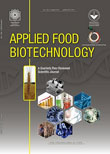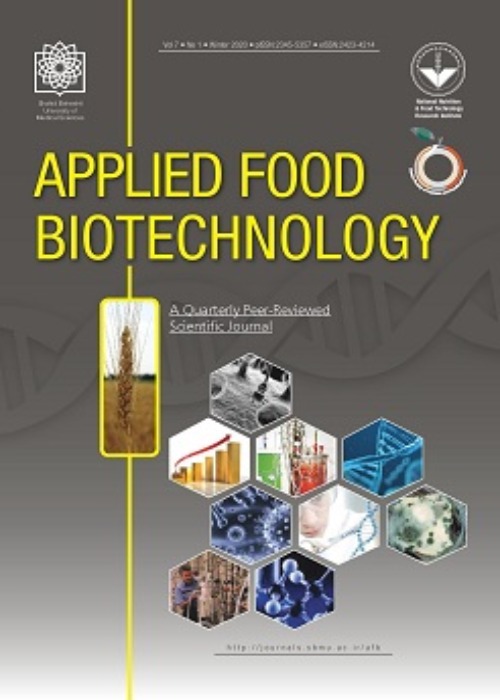فهرست مطالب

applied food biotechnology
Volume:2 Issue: 3, Summer 2015
- تاریخ انتشار: 1394/07/11
- تعداد عناوین: 7
-
-
Pages 3-15The potential and performance of various Gram-negative, Gram-positive and archaeal wild type microorganisms, and bacterial mixed cultures, as well as the application of genetically engineered strains as whole-cell biocatalysts for glycerol-based polyhydroxyalkanoate production are analyzed and assessed. This encompasses the comparison of growth and polyhydroxyalkanoate accumulation kinetics, thermo-mechanical properties of isolated glycerol-based polyhydroxyalkanoate of different composition on the monomeric level, and the presentation of mathematical models developed to describe glycerol-based polyhydroxyalkanoate production processes. For all these aspects, the article provides a detailed compilation of the contemporary state of knowledge, and gives an outlook to expected future developments.Keywords: Biopolyester, Glycerol, Kinetics, Mathematical modelling, Polyhydroxyalkanoates (PHA)
-
Pages 17-27Due to poor solubility in lipids, many of bioactive components (Nutraceutical materials) show less bioactivity than optimal state in water solution. Phytosomes improve absorption and bioavailability of biomaterials. Liposomes, spherical shaped nanocarriers, were discovered in the 1960s by bangham. Due to their composition, variability and structural properties, liposomes and phytosomes are extremely versatile, leading to a large number of applications including pharmaceutical, cosmetics and food industrial fields. They are advanced forms of herbal formulations containing the bioactive phytoconstituents of herb extracts such as flavonoids, glycosides and terpenoids, which have good ability to transit from a hydrophilic environment into the lipid friendly environment of the outer cell membrane. They have better bioavailability and actions than the conventional herbal extracts containing dosage. Phytosome technology has increasing effect on the bioavailability of herbal extracts including ginkgo biloba, grape seed, green tea, milk thistle, ginseng, etc., and can be developed for various therapeutic uses or dietary supplements. Liposomes are composed of bilayer membranes, which are made of lipid molecules. They form when phospholipids are dispersed in aqueous media and exposed to high shear rates by using micro-fluidization or colloid mill. The mechanism for formation of liposomes is mainly the hydrophilic–hydrophobic interactions between phospholipids and water molecules. Here, we attempt to review the features of phytosomes and liposomes as well as their preparation methods and capacity in food and drug applications. Generally, it is believed that phytosomes and liposomes are suitable delivery systems for nutraceuticals, and can be widely used in food industry.Keywords: Phytosomes, Liposomes, Encapsulation, Plant extract, Bioavailability
-
Pages 29-37The effects of inclusion of Allium sativum on yogurt formation and subsequent storage (4°C, up to 28 days) on proteolysis, microbial activity, the inhibition of a-amylase, a-glucosidase and angiotensin-1 converting enzyme (ACE-1) in vitro were investigated. A. sativum-yogurt showed higher rates of pH reduction and increment of TA than plain-yogurt during incubation at 41°C. Highest proteolysis, on day 7 showed in A. sativum-yogurt (62.7±0.80 mg/mL), which was 2-flod higher than plain yogurt (31.0±0.96 mg/mL). Bacterial counts in A.sativum-yogurt were higher for Lactobacillus spp. but lower for S. thermophillus (p<0.05) compared to those in plain yogurt throughout refrigerated storage. Highest inhibitory activities for α-amylase were recorded on day 14 of storage for A. sativum- and plain-yogurts (IC50= 13.7±1.99and 26.3±2.15mg respectively; p<0.05) and on day 7 for α-glucosidase (IC50= 120.7±22.71 and 192.3±33.24mg respectively; p<0.05). The highest anti-ACE-I activity was observed on day 7 of refrigerated storage with A. sativum-yogurt (IC50=6.9±0.23mg) being more potent than plain-yogurt (IC50=9.7±0.12mg; p<0.05). A. sativum-yogurt was not favoured for overall aroma, sourness and bitterness in the sensory evaluations but recorded the same overall preference as plain yogurt. A. sativum enhanced the fermentation of yogurt in favour of the population of Lactobacillus spp, stimulated proteolysis of milk proteins and increased the in vitro inhibition of key enzymes associated with diabetes and hypertension.Keywords: α glucosidase, α amylase, Allium sativum, Angiotensin converting Enzyme, Yogurt
-
Pages 39-47In order to reduce the costs associated with Poly-β-hydroxybutyrate production, growth and Poly-β-hydroxybutyrate production of Ralstonia eutropha were studied in batch culture on different carbon sources. Experiments were designed and conducted to not only lower the cost of Poly-β-hydroxybutyrate production by using inexpensive substrates, but also to increase Poly-β-hydroxybutyrate production by optimizing the culture medium composition. Low cost, abundant carbon sources, including cane molasses, beet molasses, soya bean, and corn steep liquor were used to investigate the possibility of Poly-β-hydroxybutyrate production in such renewable carbon sources. Based on the experimental results, cane molasses with production of 0.49 g/L Poly-β-hydroxybutyrate was selected as the most efficient carbon source. To improve bacterial growth and Poly-β-hydroxybutyrate production, different chemicals were then used to pretreat the cane molasses. Sulfuric acid, with 33% enhancement in Poly-β-hydroxybutyrate production, revealed the highest efficiency in removing heavy metals and suspended impurities and was used to pretreat cane molasses in the subsequent experiments. Additionally, to make the process even more efficient and ultimately more effective, urea and corn steep liquor were used as nitrogen/minerals and vitamin sources, respectively. Using the Response Surface Methodology and through a 2n factorial Central Composite Design, the medium composition was then optimized, and maximum biomass concentration of 5.03 g/L and Poly-β-hydroxybutyrate concentration of 1.63 g/L were obtained.Keywords: Cane molasses, Optimization, Polyhydroxybutyrate, Ralstonia eutropha, Response Surface Methodology
-
Pages 49-55This study evaluated the antimicrobial activities of two lactic acid bacteria (LAB) Lactococcus lactis subsp. lactis I23 and L. lactis subsp. hordinae E91 against Brochothrix thermosphacta in pork during storage at ambient temperature (30oC) over 7 days. Both the LAB strains and spoilage organism were inoculated on fresh pork samples at 1x106cfu/g. About 3 log reduction in the spoilage organism was obtained in LAB treated samples after 48 h of storage. The spoilage organism was confirmed to be sensitive to the bacteriocin nisin produced by Lactococcus lactis subsp. lactis I23. There were reductions in the counts of Salmonella typhimurium, Listeria monocytogenes, Enterobacteriaceae and Staphylococcus in the treated samples. Conclusively, growth of B. thermosphacta could be effectively controlled by nisin producing Lactococcus lactis subsp. lactis I23 in fresh pork during storage, thereby enhancing shelf life of the product.Keywords: pork, safety, lactic acid bacteria, Lactococcus lactis, Brochothrix thermosphacta
-
Pages 57-62Ganoderma lucidum is one of the most well-known fungi, and has many applications in medicine. Ganoderic acid is among the valuable secondary metabolites of Ganoderma lucidum, and responsible for the inhibition of the tumor cell growth and cancer treatment. Application of ganoderic acid has been limited because of low yields of its production from Ganoderma lucidum. The present study aims to investigate the synergistic effect of elicitors including methyl jasmonate and aspirin on the production of ganoderic acid derived from Ganoderma lucidum mushroom in a shaken flasks using response surface methodology. The results showed that the optimal dose of methyl jasmonate and asprin significantly impacts on the amount of ganoderic acid production as a response (p<0.05). The proposed model predicted the maximum ganoderic acid production as 0.085 mg/ml in which the optimal concentrations obtained for methyl jasmonate and asprin were 250mM and 4.4mM, respectively. Also the influence of ganoderic acid production on the expression of 3-hydroxy-3-methyl-glutaryl coenzyme A reductase and squalene synthase (two important metabolic pathway genes in ganoderic acid) was investigated, and the results showed that these genes’ expression has increased by 10 and 11 folds, respectively.Keywords: Cancer, Elicitor, Ganoderic acid, Ganoderma lucidum, Gene expression
-
Statistical Optimization of Tannase Production by Penicillium sp. EZ-ZH390 in Submerged FermentationPages 63-70Tannase has several important applications in food, feed, chemical and pharmaceutical industries. In the present study, production of tannase by mutant strain, Penicillium sp. EZ-ZH390, was optimized in submerged fermentation utilizing two statistical approaches. At first step, a one factor at a time design was employed to screen the preferable nutriments (carbon and nitrogen sources of the medium) to produce tannase. Screening of the carbon source resulted in the production of 10.74 U/mL of tannase in 72 h in the presence of 14% raspberry leaves powder. A 1.99-fold increase in tannase production was achieved upon further screening of the nitrogen source (in the presence of 1.2% ammonium nitrate). Then the culture condition variables were studied by the response surface methodology using a central composite design. The results showed that temperature of 30°C rotation rate of 85 rpm and fermentation time 24h led to increased tannase production. At these conditions, tannase activity reached to 21.77 U/mL, and tannase productivity was at least 3.55 times (0.26 U/mL.h) in compare to those reported in the literature. The present study showed that, at the optimum conditions, Penicillium sp. EZ-ZH390 is an excellent strain for use in the efficient production of tannase.Keywords: One factor at a time_Penicillium sp. EZ_ZH190_Response surface methodology_Statistical design_· Tannase ime


